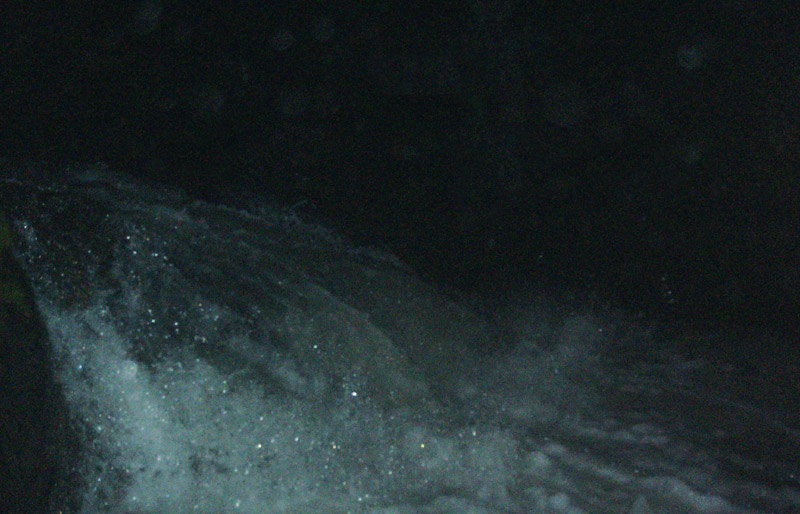An exploratory descent of the East Fork Collowash
By Jason Rackley
![]()
An exploratory descent of the East Fork Collowash
By Jason Rackley
It was the Saturday morning after the 2007 PDX Kayaker Film Festival and I was still comatose when my phone rang. "Helloo.." I mumbled, struggling to kickstart my sleep-deprived brain. "Hey." Pete said, sounding only marginally better. "You up? I checked the gauges.."
The Film Festival had brought the rain. It was only October but it had been pouring all week, and you could measure the excitement with a voltmeter on the listservs. Everyone was psyched. Of course, Pete and I weren't interested in the guidebook runs on the first big weekend of the season.
Instead, we consulted 'The List'.
The List is an informal and ever-shifting list of exploratory runs/First Known Descents that must be done before the snow closes off access. Each year in the fall after the first big rain a tiny window of opportunity exists to do some of the runs on The List. Each year we knock one or two off the list if we are lucky in the fall, then add a couple over the summer if our off-season mapwork and explorations yield fruit.
Of course, there are very good reasons why most of these runs have either never been done, or aren't considered by anyone. Most of the runs have terrible access, unknown quality, and a variety of other problems. However, the more remote the run, the more interesting it is to us.
When all of the rain started falling I sent an email out to a few of the usual suspects.
The subject line of the email read: "Prepare to Suffer."
"Ok, tomorrow is going to be one of the best boating days of the year, which is why Pete and I are gambling on a completely unknown bit of whitewater way up high in the Clackamas drainage that will probably completely suck. Pete calls it 'Fish Creek lite'. That alone should keep everyone away who has any common sense whatsoever.."
There was more, but you get the idea. Rally the troops, get them excited and all that. Amazingly Jon and Mike bit, but the group fell apart somewhat Saturday morning when I overslept, so Jon and Mike went off to do Opal Creek after they didn't hear from me. So, it was just me and Pete.
We met just outside Estacada and headed East. We had about fifty miles of driving to reach the point where we were going to start the hike, so we tried to move as quickly as we could. The rain continued to fall off an on as we climbed up into the Cascades.
Driving up the main stem of the Collowash during the one-way shuttle
After many forks and turns, we ended up on a narrow gravel road and started climbing. Soon we reached the take out and dropped a car near Elk Lake Creek. As we climbed towards the end of the road the rain turned to snow and started falling in earnest. After climbing for three or four miles the road ended and we unloaded our gear. We were now at elevation and it felt very cold as the snow fell heavily around us.
The end of the road and the start of our 3.5 mile hike.
We decided to drag our boats because there was enough snow to keep our boats from being damaged. This was also a way for us to conserve energy because we expected things to get tough. We passed a few huge berms dug in the road ( it seems there was a determined effort to keep people from using this road before the creeks blew it out ).
After a quarter mile or so we reached Ogre Creek and found an even bigger road blowout than the one where we had left the car.
"This is going to suck." Pete said as he surveyed the giant mess in front of us. He dropped out of sight and then I heard a yell as he fell into the creek, getting his feet wet. I followed more carefully and managed to keep my feet dry, delaying the inevitable.
The climb around Ogre Creek consumed about twenty minutes and involved our first big logjam portage. Towards the end of the portage Pete's boat slipped away from him and fell under the logjam and into the creek, our first delay caused by the snow which made the footing treacherous.
"This is going to suck."
Pete finishes up the portage of the massive Ogre Creek road blowout. We started on the road visible in the background.
This was our first logjam portage, and we weren't even on the river yet.
Once past the Ogre Creek blowout the road solidified and we started making very good time. The snow, which had never really stopped, fell harder the higher we climbed.
Climbing up to the top of the ridge on the abandoned logging road.
Along the way we encountered a couple of hapless Salamanders, semi-frozen while trying to cross the road, caught in this early snow. They were moving in ultra-slow motion over the ever-deepening snow, and it didn't look good for them. We took pity and tossed them in the woods so they would have a chance, however slim.
The snow was now falling so hard that we had to stop periodically to scrape it off of our boats. It was surprising how much weight an inch or two of snow added to your boat, but it was noticeable.
Soon the road forked and then we started scouting out the side roads dropping down into the river canyon. None of them them seemed to go anywhere, so we finally just selected a break in the trees that looked good and began our descent. We estimated that we had about three quarters of a mile to go to the river, and we found a replanted clear cut to make the going a little easier.
Pete cleans the snow out of his helmet so he can put it on as we start our descent into the river canyon.
After several steep pitches we broke out into a wide open area under the old growth canopy. We still weren't exactly sure where the river was, but we were relieved to be out of the snow, even temporarily.
While Pete started changing into his drysuit I decided to try and find the river. We were near a small tributary that wandered off through the woods so I followed it. After about a hundred yards I heard the rush of a much larger body of water, which turned out to be the East Fork. When I got back to Pete he nearly had his drysuit on and once he was done we finished dragging our boats over to the river.
Once we reached the river we ate the last of our food, a couple of Tigers Milk Peanut Crunch bars that were frozen solid but ooooh so good. I also had a little bit of Power Aid swirling around in the bottom of my water bottle, and we gulped that down too. Ok, now we were feeling a little better.
Glad to be out of the snow for the moment. Getting ready under the old growth canopy near the East Fork.
Now that we weren't exerting ourselves we started to feel the cold. I was having problem getting my fingers to work properly, especially after I scraped all of the snow out from around my cockpit to get my spraydeck on.
Having trouble getting the fingers to work.. Pete tries to get his spraydeck on.
We started downstream and immediately encountered a logjam. Not the best way to start, but we portaged it quickly. Downstream the river rolled along with small rapids and then an ever larger logjam appeared. We took out on the right and dragged, climbed, and grovelled our way through the snow and water.
A big logjam portage just below the put in.
Below this large logjam portaged the gradient picked up somewhat and there were some interesting rapids, though nothing too significant. That soon changed though. Soon we arrived at a steep bouldery rapid that dropped between vertical walls. I was in the lead and could see that the creek turned abruptly to the right below and went over something but I couldn't tell what.
I decided to probe and as I came down there was a hidden rock that kicked my bow to the right and nearly sent me over a large horizon line just downstream. It was a near thing, but I managed to claw my way into the eddy on the left.
While Pete worked his way down I got out to scout the falls, which split around a rib of rock in the center of the creek. Once I got a look at the drop I was glad I hadn't gone over it blind.
The left side of the falls crashed over and onto a flat bench, creating a really nice fountain effect. The right side looked more runnable, but the right side had shallow spots which made the whole drop questionable in our minds. We decided to portage on the left.
The first significant drop, a falls with a questionable pool depth, especially on the right side.
We decided to portage on the left.
Downstream of the falls the rapids picked up somewhat and the river grew more scenic. Soon the boulder gardens got big enough to warrant a scout, and we started working our way down after checking each drop carefully for wood and boulders. There were some really good rapids in there.
A log portage in the middle of a nice steep section. This went on for awhile and there was more upstream.
We put in below these logs and ran the rest of the fun stuff pictured downstream.
It was nearly dark now, and if the creek coming in on the right was Round Creek we had just reached our planned put in for the run and still had two and a half miles to go. That meant we had hiked way too far upstream and put in far higher than expected. Not good.
We got out our head lamps and continued cautiously downstream in the growing darkness. Pete had a much brighter headlamp than I did so he led. Soon we came to a horizon line. Pete caught an eddy at the lip then dropped out of sight. I grabbed the same eddy and tried to see down into the rapid but was having trouble with my dim headlamp. Against my better judgement I dropped in, and got kicked to the left in the first hole and then pinned against a midstream boulder.
The cold, dark water enveloped me as I pulled my skirt and flushed under my boat. I popped up downstream just in time to see the water tearing down violent chute on the right into a boulder. I put my feet in front of me and careened off the boulder, through a hole, and out into the moving water below. I could hear Pete yelling as I swam hard for the right bank, and he paddled over to make sure I was ok.
I told him I was fine and started hiking back upstream to get my boat, which was stuck on the boulder near the right bank. After some wrestling we were able to pop it free, and I drained it out.
After checking my boat I got a lucky break: My ExStream water bottle filter had somehow stayed in my boat, so we had as much water as we needed. No food though. We had eaten the last of that at the put in.
After a brief discussion we decided that the nature of the river made paddling any further downstream in the dark a very dangerous proposition indeed. This left us with a decision to make, but I don't think we ever considered doing anything but hiking downstream. Staying overnight wasn't an option, and abandoning our boats and coming back the next morning seemed like a huge waste of time and resources.
So, we decided to continue downstream, portaging our way along the bank of the creek. Pete estimated we had about two and a half miles until we reached the car, assuming that was Round Creek on our right.
Two and a half miles is not a long way if you are paddling down a creek. On the other hand, if you are portaging your way along an icy creek in the dark in the freezing cold, two miles feels more like forty.
Without elaborating too much, I will say that it was brutal, back-breaking work. We tried to stay in the creek as much as possible in order to let the water carry the weight of the boats, but that had it's own difficulties. Several times our boats flipped and filled with water, forcing each of us to waste crucial energy wrestling and draining a boat full of water. Other times our boats would be pulled out into the current and into a wave hole without warning, leading to an energy-draining tug-of-war with the creek.
After this happened to both of us, we decided to put our skirts on our boats and tie off the tunnel to keep the boats dry. This helped keep the water out but didn't keep the boats from misbehaving. It seemed like it was a constant battle to keep the boats from being swept downstream, tugging and pulling and hauling on the boat, then up and over logs, boulders, and around rock walls.
Walking in the creek in the dark was extremely difficult. I must've fallen down hard twenty or thirty times, and this beating manifested itself the next day: I could hardly bend my knees the following morning they were so swollen.
Little by little, our precious energy reserves trickled away. The freezing temperatures probably accelerated the process, as well as the fact that we were trying to stay in the water as much as possible to support the weight of the boats.
The walled-out sections were the worst. My energy levels were already seriously depleted which turned the vertical sections into nightmares. I felt like I was climbing Mount Everest or something.. Haul the boat up six feet. Rest. Repeat.. Repeat.. I muttered the same words over and over again: "Keep moving.. No matter how slowly.. Don't stop moving.."
Working our way downstream in the darkness.
Of course, the river had other plans.
Just downstream of Ogre Creek we found ourselves confronted with a true vertical-walled gorge with a significant rapid in it. We stopped upstream and worked our way across to the left hand side of the creek, which appeared to be the best side to scout.
Our scout did not bring welcome news. The creek rushed down over a bouldery drop and then over a six-foot ledge that reminded me of a smaller version of Chaos on the Little White. The left side of the drop fell into the wall, with no way out of the hole that I could see. The middle and right side looked better, but the hole was retaining.
To make matters worse, the creek folded nearly over onto itself thirty feet below this ledge, turning right abruptly and dropping over something that sounded at least as big as the ledge below us.
"Well, we have to run this, looks like." Pete said calmly. "Yeah." I agreed. Didn't look like any other way. Of course, at this point we didn't feel like portaging anymore. It was way past time to get in our boats and fire it up.
Since he had the brighter headlamp, Pete decided to go first while I stood above the hole with a rope. Of course, I was on the wrong side of the creek to get his gear if he swam, but the left side was where the ledge fell against the wall so it was best from a safety standpoint.
Soon Pete came flying down, his headlamp sending beams of light bouncing madly off the rock walls as he sailed over the ledge and subbed out through the foam pile. He emerged clean and straight and caught the eddy against the right wall.
My turn. I climbed back up to my boat and decided to run the drop with my eyes closed because my dim headlamp was wreaking havoc with my depth perception. I peeled out in the current and felt myself accelerate downstream. I angled my boat to the right and as I felt myself climb up onto the lip of the ledge I took a big boof stroke and shot over the ledge and into the pool below. I scrambled into the eddy and breathed a sigh of relief.
The gorged-out ledge we were forced to run in the dark. I closed my eyes when I ran this drop so I could better visualize it.
A quick scout downstream revealed a really nice runnable drop, assuming we had light. As it was we were forced to portage again, and again, and again. I remember we took a short water break just downstream from the ledge, and this was the first time I actually felt tired enough to fall asleep, vs. just physically tired. There are many different kinds of tired, and I was feeling them all on this particular night.
After our all too brief water break we got up and started working our way downstream again. Within a couple of minutes I saw a gray rock wall on the left side, and I remember thinking that we had reached another gorge. I stopped and blinked a few times as my exhausted mind processed that I was actually looking at the 'Bridge to Nowhere' overhead, which meant we were done!
I whooped and yelled to Pete that we were at the bridge, and just like tha we were done. I felt a sudden burst of energy and swung my boat up onto my shoulder, climbed up to the bridge, and walked out to the car.
I had brought some cheese and sourdough bread, and Pete and I split it first thing when we got to the car. As we chomped on these incredibly delicious delicacies we loaded our boats on the car and changed into our oh-so-amazingly-good warm, dry clothes.
I checked the clock in my car and it read 11:58 p.m. It had been almost twelve hours since we left Pete's car and started hiking, and the last two and a half miles of portaging down the creek in the dark had taken us nearly six hours to complete..
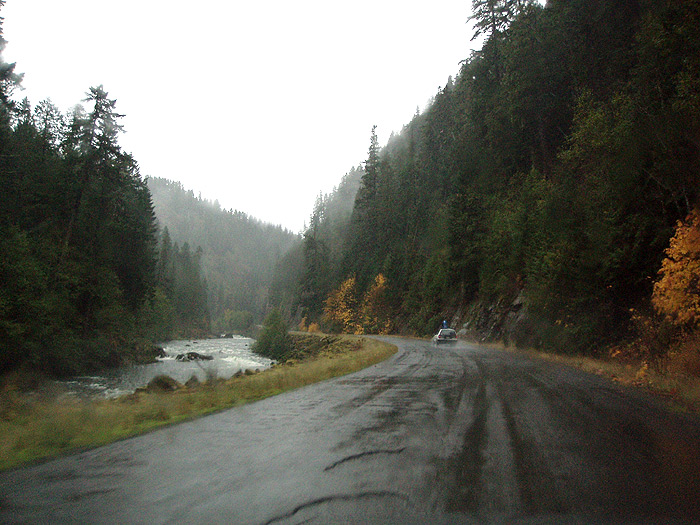
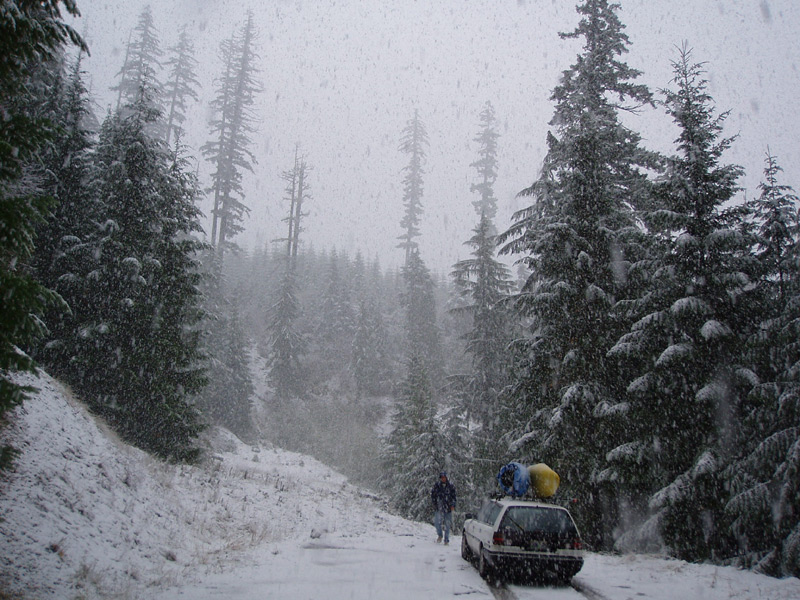
Pete contemplates the huge road blowout at Ogre Creek.
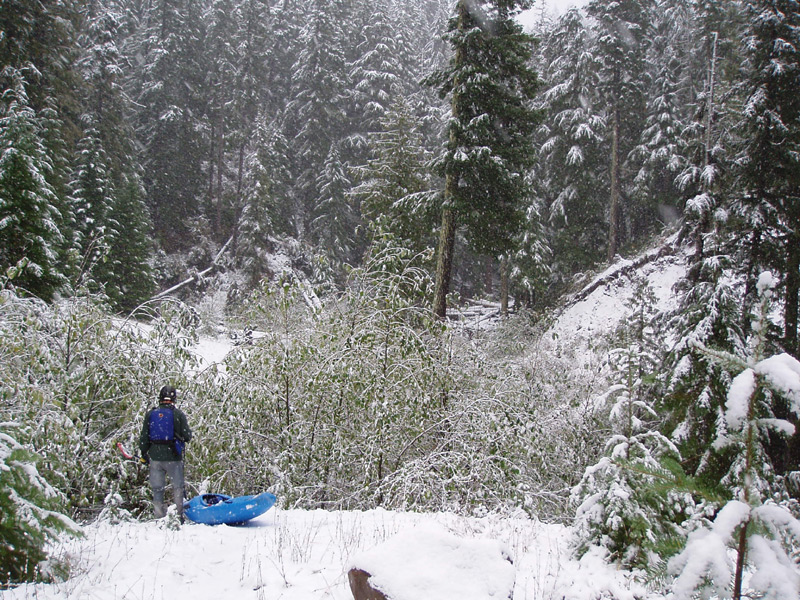
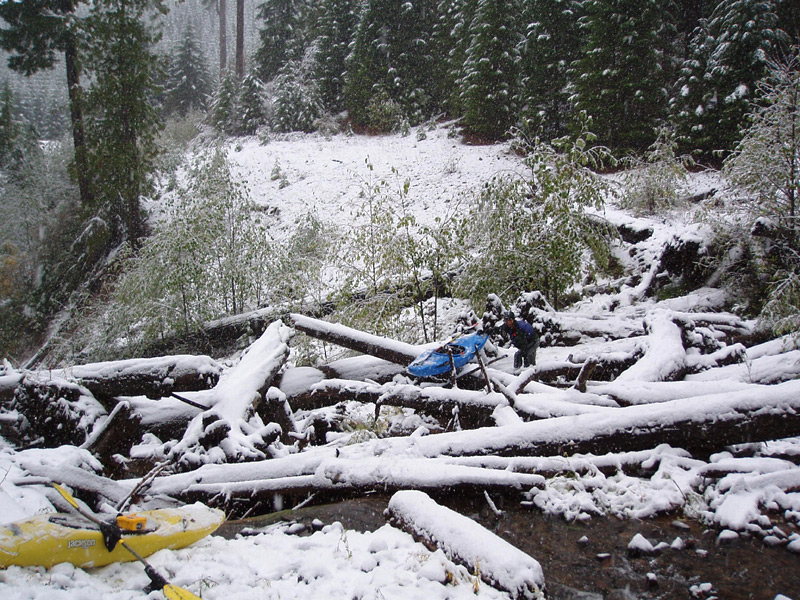
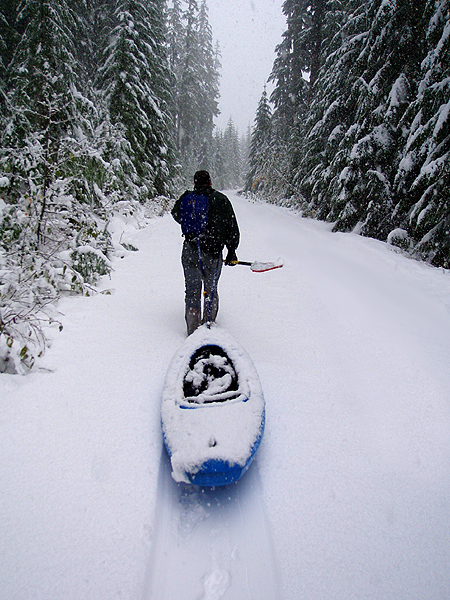
The river was about a half mile away at this point.
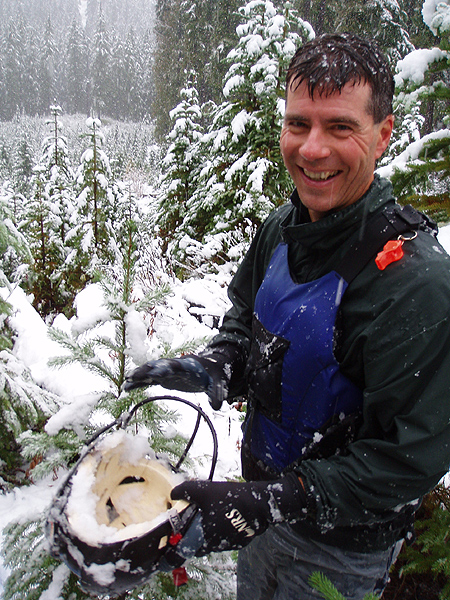
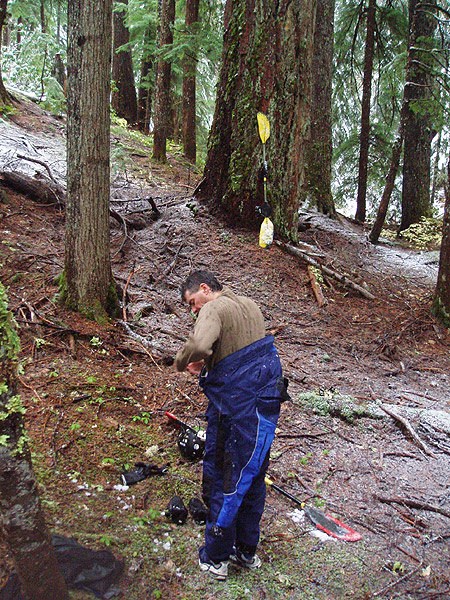
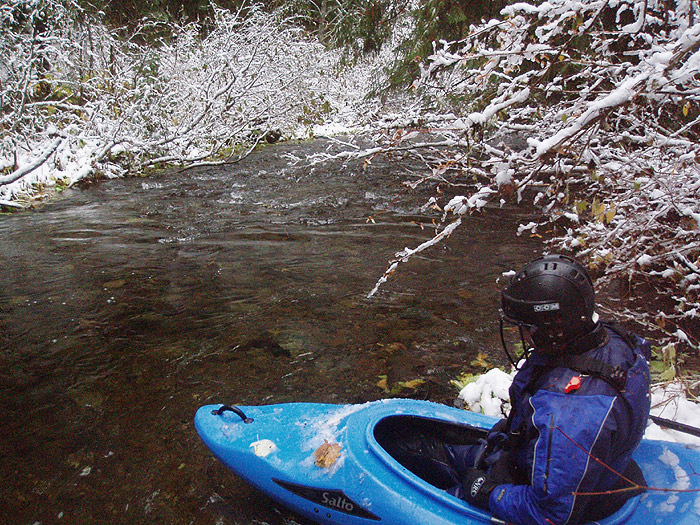
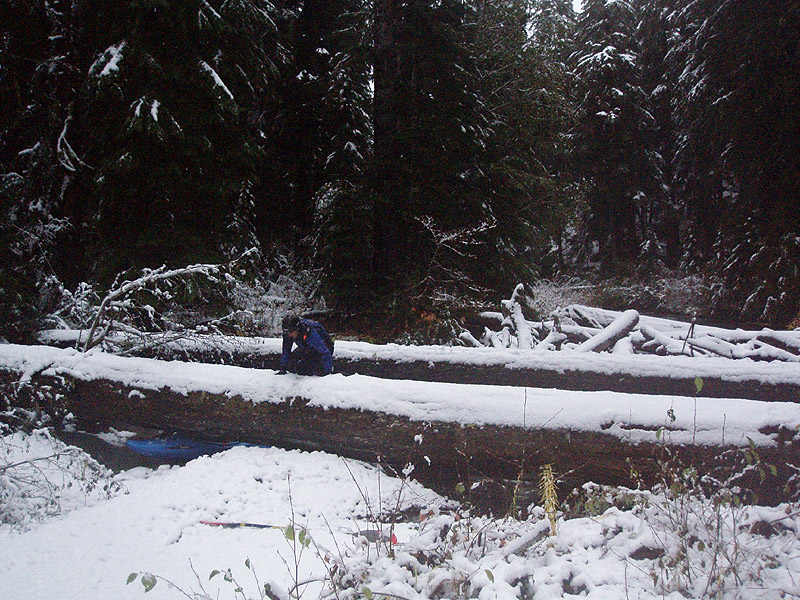
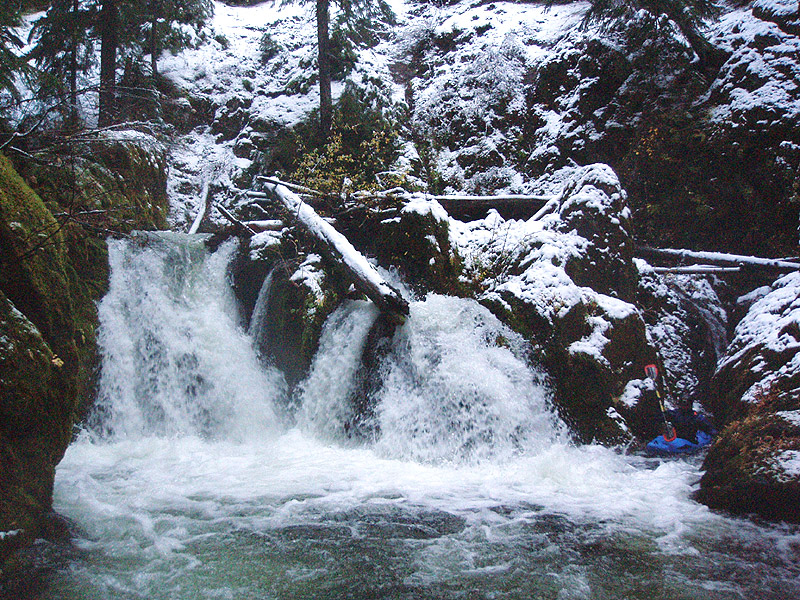
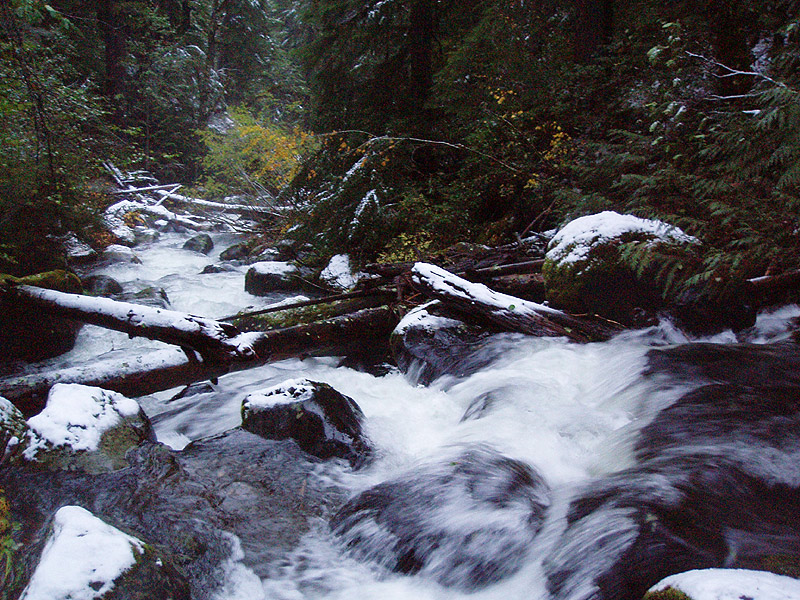
![]()
Soon we reached a steep tributary coming in through the canyon wall on the creek-right side. "If that's Ogre Creek we're getting pretty close." Pete said, sounding unsure. We caught an eddy and looked up the creek and could see the ridge line far above us. It didn't look like the terrain around Ogre to me, which wasn't good news. It looked more like Round Creek. We were both thinking it and Pete put it into words: "I hope that isn't Round Creek.. If it is we're f--cked."
![]()
"The worst part is not knowing where we are." Pete said. "It wouldn't be so bad if we knew for sure that was Round Creek."
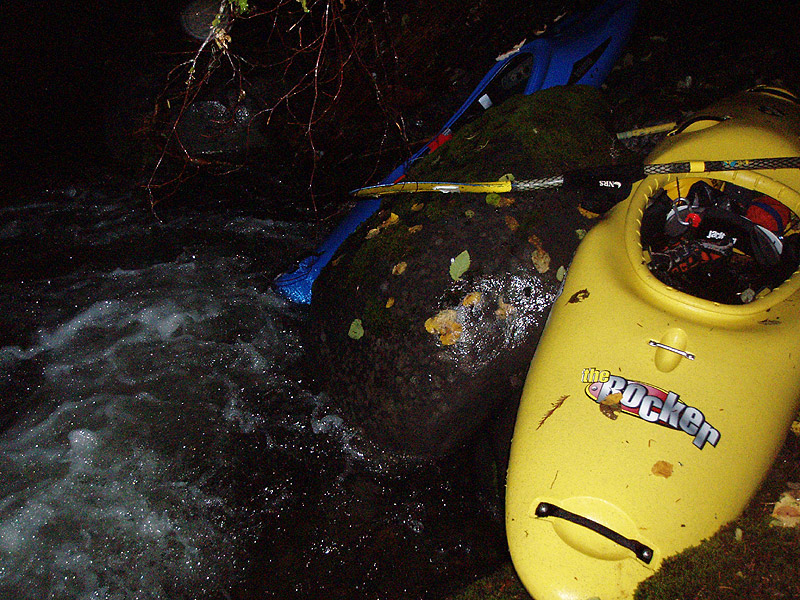
![]()
Finally we reached what we thought was Ogre Creek, and our spirits rose slightly. If we were right, we only had about a half mile to go. It is amazing what a little morale boost will do, because I felt a slight boost in my rubbery legs at this good news.
A wall on creek-left backs up this hole.
